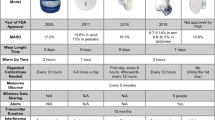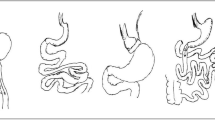Abstract
Purpose
To find out the best location for intestinal electrical stimulation (IES) to decrease hyperglycemia, and mechanisms involving intraluminal nutrients and plasma glucagon-like peptide-1 (GLP-1)
Materials and Methods
Eight rats had electrodes implanted at the duodenum and ileums for IES. The oral glucose tolerance test (OGTT) was performed with IES and sham-IES and with/without GLP-1 antagonist, exendin. To study the role of intraluminal nutrients, the experiment was repeated using intraperitoneal glucose tolerance test (IPGTT). Glucagon was administrated in the OGTT/IPGTT to induce temporary hyperglycemia.
Results
(1) In the OGTT, IES at the duodenum reduced blood glucose from 30 to 120 min after oral glucose (P < 0.05, vs. sham-IES) and the hypoglycemic effect was more potent than IES at the ileum. (2) The hypoglycemic effect of IES was absent in IPGTT experiment, suggesting the important role of intraluminal nutrients. (3) An increase in GLP-1 was noted in the OGTT with IES at the duodenum in comparison with sham-IES. Moreover, the blocking effect of exendin suggested the role of GLP-1 in the hypoglycemic effect of IES.
Conclusions
The best stimulation location for IES to decrease hyperglycemia is in the duodenum. The hypoglycemic effect of IES is attributed to the enhancement in nutrient-stimulated release of GLP-1.



Similar content being viewed by others
References
Pfeiffer AF, Klein HH. The treatment of type 2 diabetes. Dtsch Arztebl Int. 2014;111(5):69–81. quiz 82
Puzziferri N, Roshek 3rd TB, Mayo HG, et al. Long-term follow-up after bariatric surgery: a systematic review. JAMA. 2014;312(9):934–42.
Maggard-Gibbons M, Maglione M, Livhits M, et al. Bariatric surgery for weight loss and glycemic control in nonmorbidly obese adults with diabetes: a systematic review. JAMA. 2013;309(21):2250–61.
Qaseem A, Barry MJ, Humphrey LL, et al. Oral pharmacologic treatment of type 2 diabetes mellitus: a clinical practice guideline update from the American College of Physicians. Ann Intern Med. 2017;166(4):279–90.
Nathan DM. Diabetes: advances in diagnosis and treatment. JAMA. 2015;314(10):1052–62.
Chen JD, Yin J, Wei W. Electrical therapies for gastrointestinal motility disorders. Expert Rev Gastroenterol Hepatol. 2017;11(5):407–18.
Zhao X, Yin J, Chen J, et al. Inhibitory effects and mechanisms of intestinal electrical stimulation on gastric tone, antral contractions, pyloric tone, and gastric emptying in dogs. Am J Physiol Regul Integr Comp Physiol. 2009;296(1):R36–42.
Li S, Zhu W, Zhang S, et al. Chronic intestinal electrical stimulation improves glucose intolerance and insulin resistance in diet-induced obesity rats. Obesity (Silver Spring). 2017;25(6):1061–8.
Wan X, Yin J, Foreman R, et al. An optimized IES method and its inhibitory effects and mechanisms on food intake and body weight in diet-induced obese rats: IES for obesity. Obes Surg. 2017;27(12):3215–22.
Ouyang X, Li S, Foreman R, et al. Hyperglycemia-induced small intestinal dysrhythmias attributed to sympathovagal imbalance in normal and diabetic rats. Neurogastroenterol Motil. 2015;27(3):406–15.
Khawaled R, Blumen G, Fabricant G, et al. Intestinal electrical stimulation decreases postprandial blood glucose levels in rats. Surg Obes Relat Dis. 2009;5(6):692–7.
Liu J, Xiang Y, Qiao X, et al. Hypoglycemic effects of intraluminal intestinal electrical stimulation in healthy volunteers. Obes Surg. 2011;21(2):224–30.
Li S, Chen JD. Pulse width-dependent effects of intestinal electrical stimulation for obesity: role of gastrointestinal motility and hormones. Obes Surg. 2017;27(1):70–7.
Williams DL, Baskin DG, Schwartz MW. Evidence that intestinal glucagon-like peptide-1 plays a physiological role in satiety. Endocrinology. 2009;150(4):1680–7.
Gibbons CH, Goebel-Fabbri A. Microvascular complications associated with rapid improvements in glycemic control in diabetes. Curr Diab Rep. 2017;17(7):48.
Kawanami D, Matoba K, Sango K, et al. Incretin-based therapies for diabetic complications: basic mechanisms and clinical evidence. Int J Mol Sci. 2016;17(8).
Pecoits-Filho R, Abensur H, Betônico CC, et al. Interactions between kidney disease and diabetes: dangerous liaisons. Diabetol Metab Syndr. 2016;8:50.
Azami M, Sharifi A, Norozi S, et al. Prevalence of diabetes, impaired fasting glucose and impaired glucose tolerance in patients with thalassemia major in Iran: a meta-analysis study. Caspian J Intern Med. 2017;8(1):1–15.
Thrasher J. Pharmacologic management of type 2 diabetes mellitus: available therapies. Am J Med. 2017;130(6S):S4–17.
Yin J, Zhang J, Chen JD. Inhibitory effects of intestinal electrical stimulation on food intake, weight loss and gastric emptying in rats. Am J Physiol Regul Integr Comp Physiol. 2007;293(1):R78–82.
Aberle J, Busch P, Veigel J, et al. Duodenal electric stimulation: results of a first-in-man study. Obes Surg. 2016;26(2):369–75.
Mearin F, Camilleri M, Malagelada JR. Pyloric dysfunction in diabetics with recurrent nausea and vomiting. Gastroenterology. 1986;90(6):1919–25.
Horowitz M, Edelbroek M, Fraser R, et al. Disordered gastric motor function in diabetes mellitus. Recent insights into prevalence, pathophysiology, clinical relevance, and treatment. Scand J Gastroenterol. 1991;26(7):673–84.
Steinberg BE, Glass L, Shrier A, et al. The role of heterogeneities and intercellular coupling in wave propagation in cardiac tissue. Philos Trans A Math Phys Eng Sci. 2006;364(1842):1299–311.
Camilleri M, Malagelada JR. Abnormal intestinal motility in diabetics with the gastroparesis syndrome. Eur J Clin Investig. 1984;14(6):420–7.
Nowak TV, Harrington B, Kalbfleisch JH, et al. Evidence for abnormal cholinergic neuromuscular transmission in diabetic rat small intestine. Gastroenterology. 1986;91(1):124–32.
Wang WF, Yin JY, De Dz Chen J. Acceleration of small bowel transit in a canine hypermotility model with intestinal electrical stimulation. J Dig Dis. 2015;16(3):135–42.
Sun Y, Chen JD. Intestinal electric stimulation accelerates whole gut transit and promotes fat excrement in conscious rats. Int J Obes. 2009;33(8):817–23.
Foster C, Costill DL, Fink WJ. Gastric emptying characteristics of glucose and glucose polymer solutions. Res Q Exerc Sport. 1980;51(2):299–305.
Sandoval D, Dunki-Jacobs A, Sorrell J, et al. Impact of intestinal electrical stimulation on nutrient-induced GLP-1 secretion in vivo. Neurogastroenterol Motil. 2013;25(8):700–5.
Gribble FM, Reimann F. Signalling in the gut endocrine axis. Physiol Behav. 2017;176:183–8.
Vahl T, D'Alessio D. Enteroinsular signaling: perspectives on the role of the gastrointestinal hormones glucagon-like peptide 1 and glucose-dependent insulinotropic polypeptide in normal and abnormal glucose metabolism. Curr Opin Clin Nutr Metab Care. 2003;6(4):461–8.
MacDonald PE, El-Kholy W, Riedel MJ, et al. The multiple actions of GLP-1 on the process of glucose-stimulated insulin secretion. Diabetes. 2002;51(Suppl 3):S434–42.
Orskov C. Glucagon-like peptide-1, a new hormone of the entero-insular axis. Diabetologia. 1992;35(8):701–11.
Straub SG, Sharp GW. Glucose-stimulated signaling pathways in biphasic insulin secretion. Diabetes Metab Res Rev. 2002;18(6):451–63.
Kim DS, Choi HI, Wang Y, et al. A new treatment strategy for Parkinson’s disease through the gut-brain axis: the glucagon-like peptide-1 receptor pathway. Cell Transplant. 2017;26(9):1560–71.
Mojsov S, Weir GC, Habener J. Insulinotropin: glucagon-like peptide 1 (7–37) co-encoded in the glucagon gene is a potent stimulator of insulin release in the perfused rat pancreas. J Clin Invest. 1987;79(2):616–9.
Yin J, Kuang J, Chandalia MT, et al. Hypoglycemic effects and mechanisms of electroacupuncture on insulin resistance. Am J Physiol Regul Integr Comp Physiol. 2014;307(3):R332–9.
Knauf C, Cani PD, Perrin C, et al. Brain glucagon-like peptide-1 increases insulin secretion and muscle insulin resistance to favor hepatic glycogen storage. J Clin Invest. 2005;115(12):3554–63.
Guglielmi V, Sbraccia P. GLP-1 receptor independent pathways: emerging beneficial effects of GLP-1 breakdown products. Eat Weight Disord. 2017;22(2):231–40.
Wootten D, Reynolds CA, Smith KJ, et al. Key interactions by conserved polar amino acids located at the transmembrane helical boundaries in class B GPCRs modulate activation, effector specificity and biased signalling in the glucagon-like peptide-1 receptor. Biochem Pharmacol. 2016;118:68–87.
Nance KD, Days EL, Weaver CD, et al. Discovery of a novel series of orally bioavailable and CNS penetrant glucagon-like peptide-1 receptor (GLP-1R) noncompetitive antagonists based on a 1,3-disubstituted-7-aryl-5,5-bis(trifluoromethyl)-5,8-dihydropyrimido[4,5-d]pyrimidine-2,4(1H,3H)-dione core. J Med Chem. 2017;60(4):1611–6.
Funding
This study was supported in part by a VA MERIT grant (1I01BX002010).
Author information
Authors and Affiliations
Corresponding author
Ethics declarations
Conflict of Interest
The authors declare that they have no conflicts of interest.
A Statement of Animal Rights/Ethical Approval
All procedures in this study were approved by the Animal Care and Use Committee of the Veterans Affairs Medical Center (Oklahoma City, OK).
Rights and permissions
About this article
Cite this article
Ye, F., Liu, Y., Li, S. et al. Hypoglycemic Effects of Intestinal Electrical Stimulation by Enhancing Nutrient-Stimulated Secretion of GLP-1 in Rats. OBES SURG 28, 2829–2835 (2018). https://doi.org/10.1007/s11695-018-3257-1
Published:
Issue Date:
DOI: https://doi.org/10.1007/s11695-018-3257-1




